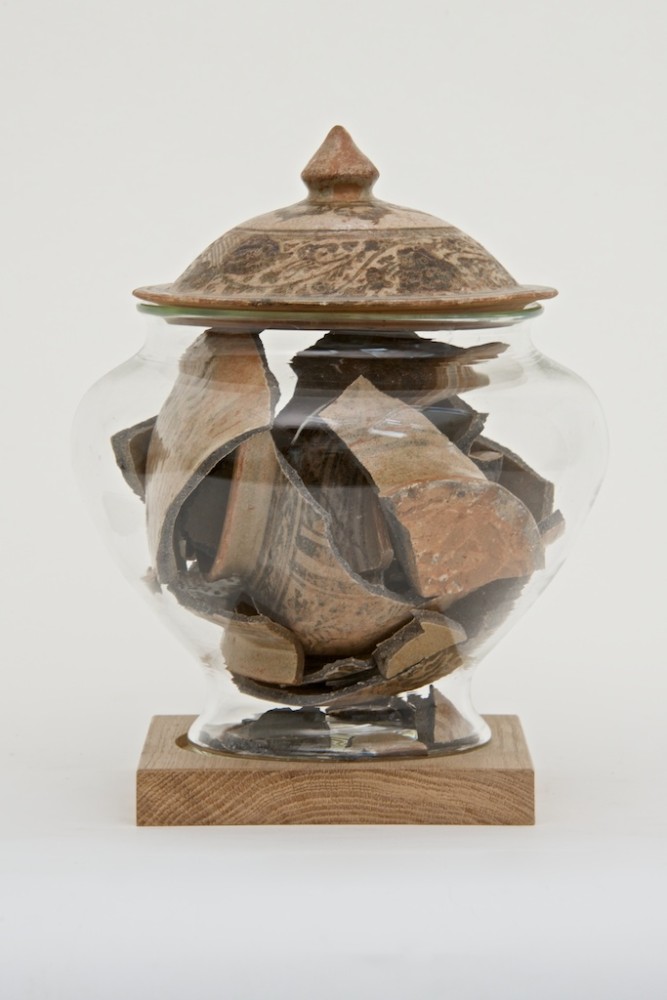Bouke de Vries’ Memories series for artSOUTH is being shown simultaneously at three venues (7 September – 23 December 2013) in Britain. Southampton City Art Gallery hosted the main installation; two ‘satellite’ commissions, at Aspex, Portsmouth and St. Barbe Museum, Lymington, complemented this show.
Collaborating with Dixon Glass, a manufacturer of custom laboratory glass, de Vries selected damaged pieces of ceramics and created glass vessels, using the original shape of the broken object. These ‘ghost’ vessels hold the fragments of the original pieces and create a conversation about the history, value, and beauty in something that could be perceived as worthless.
The shards were excavated from a spot near Bargate in the centre of Southampton and date back to the later 18th century. They are part of Southampton City Council’s Designated Archaeology Collection. The pit from which these fragments were dug was full of pottery, including lots of Chinese and English porcelain, as well as tin glazed, Verwood, salt glazed and creamware. There were a lot of chamber pots and it’s been suggested that there was an inn nearby—the sort of place that would need a regular supply of pots.
Karen Wardley (Collections Manager, SCC Arts and Heritage) writes, “It has been exciting to see ceramics from our archaeology collections re-interpreted. Each artifact has a unique story to tell – we wonder who made it, how and where it was used. By creating these ghost vessels containing original, tangible fragments Bouke encourages us to think about the histories and memories contained within them. I appreciate the careful consideration given to the reversibility of the processes used, so that in the creation of new art works, archaeological significance has not been compromised or lost.”
For de Vries, this is familiar territory, drawing on skills honed in his daily work as a conservator of ceramics and glass:
My artwork investigates different angles and interpretations of art, history, and beauty. While working on objects of great quality from major collections, both private and public – physical representations of some of mankind’s cultural high points across the world and through the ages – I have come to question the relentless demands of perfection; including many instances where trauma to a once-valuable object has rendered it, in the words of one collector, ‘not worth the cost of conserving’, despite its still being imbued with all its history, including the skill of its manufacture, the maker’s individual artistry and the piece’s cultural context and significance, what we can learn from it about ourselves, then and now, ancient and modern.
While these works deal with memory and loss I find this description is a tad mundane. For me they work better as “ghosts,” a term mentioned in passing in de Vries’ proposal and then dropped. It is the glass that pushes this metaphor, giving the broken pot a transparent spectral presence that is at once eerie and redemptive. The concept of death also works better for me than loss, similar, but more raw.
This might seem like semantics and it is. But the exercise is not a pointless one. Fine-tuning the conceptual identity of art can greatly increase its aesthetic potency. And to take the theme further, if one was to encounter a ghost from the 18th century, it would not provoke memory. It would be an encounter with the unfamiliar, a disturbance of time.
The work is stronger when it channels a single pot or spirit. Those that contain shards from many pots simply become mass graves, devoid of individuality, not a visitor from the grave with its unique from, function and identity.
That said, de Vries’ use of shards, not uncommon in contemporary ceramic art, is fresh and magical: time-warping conceptual art at its best.
Bouke de Vries, is a Dutch-born artist working primarily in ceramics whose recent exhibitions in the UK include Pallant House Gallery, Chichester; Holbourne Museum, Bath; and Middlesborough Institute of Modern Art (MIMA). De Vries has also exhibited internationally in Amsterdam, Milan, Basel and Kyoto.
Garth Clark is Chief Editor of CFile.
Image above: Bouke de Vries, Memory vessel 4, 2013. 17th century porcelain Chinese vase and cover, glass and walnut. 230 x 230 x 290 cm.

Bouke de Vries, Memory vessel/Southampton 8, 2013. 19th century English salt glaze bowl and glass.


Bouke de Vries, Memory vessel/Southampton 6, 2013. 19th century English cream ware ale jug and glass.

Bouke de Vries, Memory vessel 6, 2013. 19th century porcelain ‘sang de bouef’ Chinese vase, glass and cedar. 240 x 240 x 585 cm.

Bouke de Vries, Memory vessel 5, 2013. 18th century porcelain Chinese bowl, glass, and walnut. 265 x 265 x 160 cm.

Bouke de Vries, Memory vessel/Southampton 2, 2013. 19th century English lead glaze jug and glass.

Bouke de Vries, Memory vessel 2, 2013. 17th century porcelain Chinese vase and cover, glass, and walnut. 200 x 200 x 330 cm.

Bouke de Vries, Memory vessel/Southampton 7, 2013. 19th century English cream ware chamber pot and glass.

Fantastico!!!!!!
CREATIVITY FROM DECONSTRUCTION…
it’s a bit like “RAKU”…
Taking advantage of an accident… From Serendipity and Humility… There was no accident!
I love the series “Memory Vessels”, by Bouke de Vries. Fabulous newsletter, thank you.